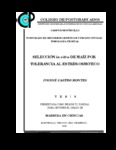| dc.contributor.author | Castro Montes, Ivonné | es |
| dc.creator | CASTRO MONTES, IVONNE | |
| dc.date.accessioned | 2012-09-08T12:23:14Z | |
| dc.date.available | 2012-09-08T12:23:14Z | |
| dc.date.issued | 2008 | es |
| dc.identifier.uri | http://hdl.handle.net/10521/1395 | |
| dc.description | Tesis ( Maestría en Ciencias, especialista en Fisiología Vegetal).- Colegio de Postgraduados, 2008. | es |
| dc.description.abstract | Se estudió la respuesta morfo-fisiológica al estrés osmótico de brotes obtenidos vía
organogénica de líneas de maíz LE-13, LE-14, LE-16 y LE- 46, durante tres
ciclos de selección in vitro. El estrés osmótico fue inducido con polietilenglicol
(PEG-8000) adicionado al medio básico MS (1962). A partir de plántulas in vitro
se disecaron secciones de coleóptilo (explante) y se sembraron en medio sólido. Se
encontraron diferencias significativas entre las líneas con respecto a: longitud de
coleóptilo, altura de plántula y número de hojas. Durante la inducción de
organogénesis, se encontró un efecto significativo del genotipo x pH, posición del
explante, consistencia del medio y del genotipo x período de subcultivo. En la
etapa de multiplicación y alargamiento de brotes el tiempo entre subcultivos (15
d) influyó significativamente en número de explantes con brotes (83 %). Estos
brotes desarrollaron mayor altura, número de hojas y peso fresco, en comparación
con LE-16 y LE-46. Durante la multiplicación bajo estrés osmótico en medio
líquido con PEG durante tres ciclos de selección, se observó un efecto significativo
de la interacción genotipo x PEG sobre altura y número de hojas por brote;
genotipo x ciclo sobre número de hojas y peso fresco, y PEG x ciclo sobre peso
fresco. En el segundo experimento se observó un efecto significativo de las
variables antes señaladas, mas el genotipo x PEG sobre los potenciales hídrico,
osmótico y ajuste osmótico total y genotipo x PEG x ciclo de selección sobre el
contenido total de proteína soluble. Con base en las variables cuantitativas
evaluadas, las mejores líneas fueron LE-14 y LE-16 debido a que presentaron
mayor ajuste osmótico y características morfo-fisiológicas superiores asociadas
con la acumulación de polímeros insolubles y prolina en el tejido del brote. Lo cual
muestra que la selección in vitro es viable para elegir los mejores genotipos._______The morpho-physiological response to the osmotic stress of shoots obtained via
organogenic of maize lines: LE-13, LE-14, LE-16 and LE- 46, was studied during
three cycles of in vitro selection. Osmotic stress was induced with polyethylene
glycol (PEG-8000) it was added to basic culture medium MS (1962). From in vitro
plantlets sections of coleoptile were dissected (explants) and they were placed in
the solid medium. Significant differences between the lines were found by way of:
length of coleoptile, height of plantlet and number of leaves. During the
organogenesis induction, was a significant effect of genotype x pH, position of the
explants, consistency of medium and genotype x period of subculture. In the stage
of multiplication and elongation of shoots the time between subcultures (15 d)
influenced significantly in number of explants with shoots (83 %). These shoots
developed a greater height, number of leaves and fresh weight, in comparison
with LE-16 and LE-46. During the multiplication under osmotic stress in liquid
medium with PEG through three cycles of selection, a significant effect of the
interaction was observed between genotype x PEG on height and number of
leaves by shoots; genotype x cycle on number of leaves and fresh weight, and PEG
x cycle on fresh weight. In the second experiment a significant effect of the
variables before indicated was observed plus genotype x PEG on the water, and
osmotic potential, and total osmotic adjustment; genotype x PEG x cycle of
selection on the total soluble protein content. Among the quantitative variables
evaluated, the best lines were LE-14 and LE-16 because they presented superior
morpho-physiological characteristics associated with a greater osmotic
adjustment and the insoluble polymer accumulation and proline in the tissue of
the shoots. This shows that the in vitro selection is viable to choose the best
genotypes. | es |
| dc.description.sponsorship | CONACYT | es |
| dc.language.iso | spa | es |
| dc.rights.uri | http://creativecommons.org/licenses/by-nc-nd/4.0 | |
| dc.subject | Estrés osmótico | es |
| dc.subject | Multiplicación de brotes | es |
| dc.subject | PEG | es |
| dc.subject | Selección in vitro | es |
| dc.subject | Zea mays L. | es |
| dc.subject.ddc | Maestría | |
| dc.subject.ddc | Fisiología Vegetal | |
| dc.title | Selección in vitro de maíz por tolerancia al estrés osmótico | es |
| dc.type | Tesis | es |
| Tesis.contributor.advisor | López Peralta, María Cristina Guadalupe | es |
| Tesis.contributor.advisor | González Hernández, Víctor Arturo | es |
| Tesis.contributor.advisor | Delgado Alvarado, Adriana. | es |
| Tesis.subject.nal | Maíz. | |
| Tesis.subject.nal | Sequía. | |
| Tesis.subject.nal | Plantas. | |
| Tesis.subject.nal | Estrés osmótico. | |
| dc.subject.ingles | Osmotic stress | es |
| dc.subject.ingles | Shoots multiplication | es |
| dc.subject.ingles | In vitro selection | es |
| dc.type.conacyt | masterThesis | |
| dc.identificator | 6 | |
| dc.contributor.director | LOPEZ PERALTA, MARIA CRISTINA GUADALUPE; 3082 | |


